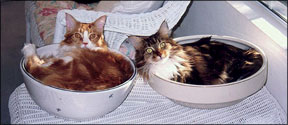You walk into a room and see a little wet spot on the floor, far from any sink or faucet. Or perhaps you find a more solid surprise. Who was responsible for this deposit? Bev Caldwell 288 If you have ever lived with more than one pet at a time, then you have surely been in this position. Your assignment: to solve The Mystery of the Puddle. Was it the dog? Was it the cat? And if you live in a multicat household, which cat did the deed? Why bother to solve the puzzle at all? Well, there may be little need to be concerned about an isolated event. But should deposits begin to appear on a regular basis, then you do need to identify the cat that is responsible. There could be an underlying medical condition driving this behavior. The appropriate cat must receive therapy. Similarly, if there is a persistent primary behavioral problem, it needs to be treated as well. So, Whodunit? There are many ways to assign blame. Most of them are flawed. For instance, a cat may be blamed simply because he has been unlucky enough to be discovered close to the mess. Similarly, being “caught in the act” of soiling, even on one single occasion, may be enough to condemn a cat for all further messes. Many people automatically assign blame to the cat that seemed to have a guilty look when confronted. Well, what is a guilty look, after all? Is it not just an assortment of postures that serve to appease us? Genetic makeup and learning predispose our pets to exhibit postures that reliably reduce the intensity of confrontations. Alternatively, when a cat isnt comfortable with the progress of an interaction with his person, he will simply run. Many humans interpret running away as a solid confession of guilt. The final flawed method of assigning blame is based on intuition. Some people insist that they “just know” which cat left the deposit. And people are often right. But just as often, they are wrong. We cannot and should not rely on intuition when attempting to manage problem behavior. Not even a behaviorist can look at a puddle on the floor and determine which cat was responsible, let alone why he did it. One could certainly create a plausible explanation complete with underlying motivation. But it would be fantasy. Consider this scenario. There is blood on one of the cat mats. The household cat that suffers from chronic sinusitis loves to sleep on this mat. Upon seeing the blood, this cats owner assumes that the infection has become more serious and rushes to the veterinarian. Relying on the owners history, the veterinarian might prescribe a new medication or order extensive tests. What if, upon returning home, the owner learns that his daughter had a “little accident” while trimming one of the cats claws. Hence the blood on the mat. Oops. With good intentions, the wrong patient received treatment for the wrong condition. Clearly, the evidence of the behavior – the blood on the mat or the puddle on the floor – is not the diagnosis. Rather, the diagnosis is based on the complete behavioral history and behavioral assessment of the patient that exhibited the behavior in question. That means we must identify all patients responsible. Lets use an example in which the evidence presented is urine outside the litter box. Puddles have been discovered both behind and in front of the television set. Did one single cat urinate in both locations and, if so, why? One possibility is that a very anxious cat is the victim of intercat aggression. He may not wish to venture into the litter box area, hence he hides behind the television to urinate – inappropriate urination due to location preference. In an attempt to mark a safe zone for himself, he sprays the front of the television – passive aggression reflected in urine marking. An equally reasonable explanation is that the victimized cat may be urinating behind the TV set where he feels safe, as described above. The more aggressive cat may be responsible for the urination in front of the television – overt aggression reflected in urine marking. In this day of technology, it is very simple to confirm which cat is responsible for any behavior. There are security cameras, videocameras, web cams, baby monitors and even laptop computers that can be stationed in strategic areas. Once we know we have identified the real patient, his condition can be diagnosed and treated. The outcome can be very good. 



